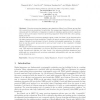Free Online Productivity Tools
i2Speak
i2Symbol
i2OCR
iTex2Img
iWeb2Print
iWeb2Shot
i2Type
iPdf2Split
iPdf2Merge
i2Bopomofo
i2Arabic
i2Style
i2Image
i2PDF
iLatex2Rtf
Sci2ools
CRYPTO
2011
Springer
2011
Springer
Optimal Structure-Preserving Signatures in Asymmetric Bilinear Groups
Structure-preserving signatures are signatures defined over bilinear groups that rely on generic group operations. In particular, the messages and signatures consist of group elements and the verification of signatures consists of evaluating pairing product equations. Due to their purist nature structure-preserving signatures blend well with other pairingbased protocols. We show that structure-preserving signatures must consist of at least 3 group elements when the signer uses generic group operations. Usually, the generic group model is used to rule out classes of attacks by an adversary trying to break a cryptographic assumption. In contrast, here we use the generic group model to prove a lower bound on the complexity of digital signature schemes. We also give constructions of structure-preserving signatures that consist of 3 group elements only. This improves significantly on previous structure-preserving signatures that used 7 group elements and matches our lower bound. Our stru...
| Added | 18 Dec 2011 |
| Updated | 18 Dec 2011 |
| Type | Journal |
| Year | 2011 |
| Where | CRYPTO |
| Authors | Masayuki Abe, Jens Groth, Kristiyan Haralambiev, Miyako Ohkubo |
Comments (0)

